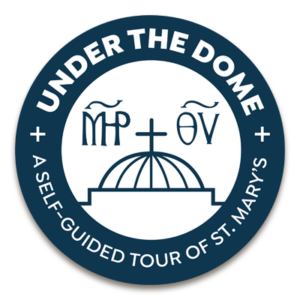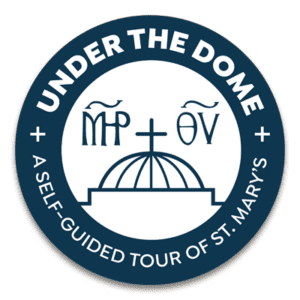

Pantokrator and the Evangelists
A massive icon of Jesus Christ hovers over the nave of the church. It is surrounded by icons of the four Gospel writers, or Evangelists, Matthew, Mark, Luke, and John.
The icon under the dome shows Jesus Christ holding the Gospels in his left hand and blessing with his right. It portrays Christ as the Righteous Judge (illustrated by the Gospel, the book by which we are judged) and the Lover of Mankind (the blessing hand shows God’s love and forgiveness of us). On either side of Christ is the inscription “IC” and “XC.” This is an abbreviation for the Greek words for “Jesus Christ” or ΙΗΣΟΥΣ ΧΡΙΣΤΟΣ. (Σ = C). He is flanked by the four Evangelists and Gospel writers, Matthew, Mark, Luke, and John.
This icon is called Christ Pantokrator and is found under most Orthodox Christian church domes or ceilings, including the early cave churches. Pantokrator is a Greek word that means The Ruler of All or The All-Mighty. This word has a deep theological context and is used many times throughout the Greek translation of the Hebrew Bible (Septuagint) as well as in the Greek New Testament in the Book of Revelations.
The Christ Pantokrator is surrounded by a circular frame, called a mandorla. At St. Mary’s, the frame is a rainbow and symbolizes the new covenant that God established with man in the personhood of Jesus. At the lower part of the dome, the Pantokrator is encircled with Christ’s promise from John 8:12, “I am the light of the world. He who follows me will not walk in darkness but will have the light of life.” As a point of interest, in the spring and fall of the year, when the western sun streams through the window late in the day, the verse lights up between the two words of “light” (φως).
St. Mary’s Christ Pantokrator was written by the hand of Demetrios Dukas, a renowned iconographer who studied under the great iconographer, Photios Kontoglou. The icon was painted in 1961 and Dukas returned in 1993 to add the four Evangelists. Dukas also painted the icons hanging on the iconostasis (the icon stand or wall in front of the altar) and the Platytera, the large icon of the Virgin Mary on the apse wall of the sanctuary (station 10 on the tour).
